Physical Address
304 North Cardinal St.
Dorchester Center, MA 02124
Physical Address
304 North Cardinal St.
Dorchester Center, MA 02124
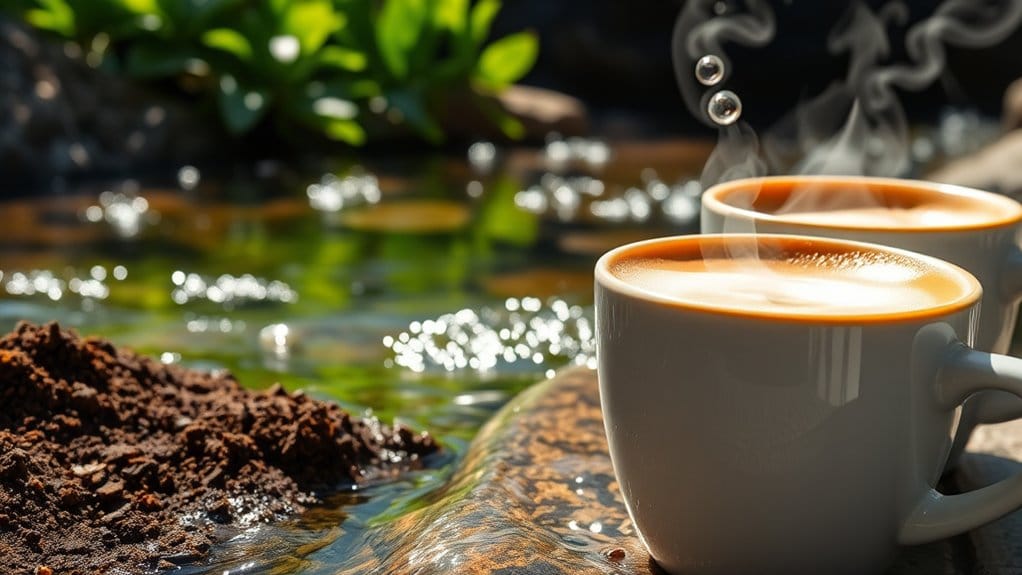
Water quality is essential for great coffee! When you brew, the type of water—whether filtered, spring, or tap—affects its taste and aroma. For instance, minerals like calcium and magnesium can brighten your brew and improve fruity flavors. Don’t forget the pH level, either! It can make your coffee sharper or smoother. A well-balanced water can bring out delicious notes. Curious about how different sources impact your cup? There’s more to investigate!
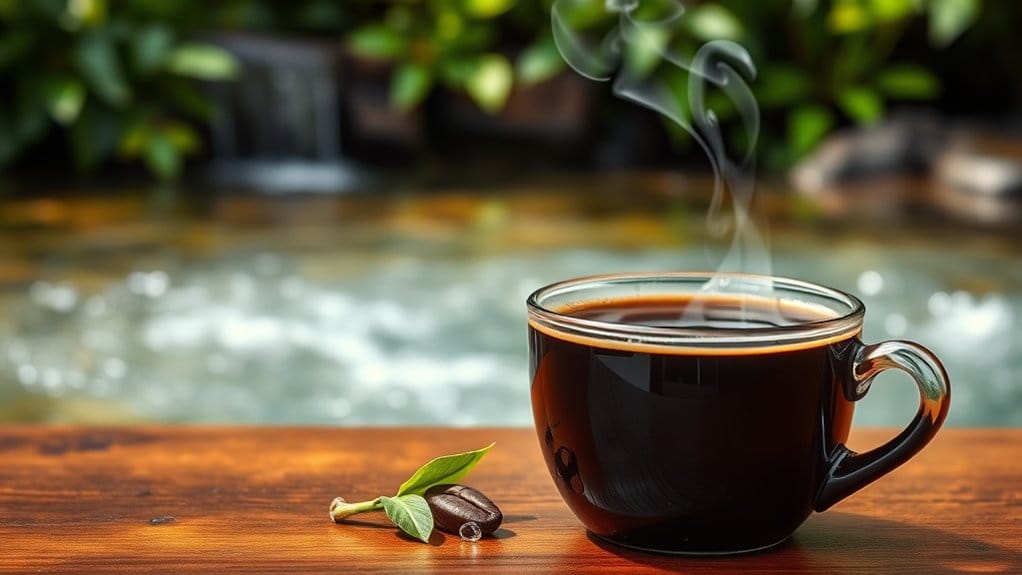
When you think about your morning cup of coffee, have you ever considered how important water quality is? Believe it or not, your brew is about 98% water!
If you’re using tap water, you might be introducing irritating impurities like chlorine or metals, which can ruin the delicate flavors of your favorite beans. Using high-quality purified water, by contrast, lets the coffee shine with clarity and brightness. This is especially important because purified water eliminates contaminants that can diminish your coffee’s taste. Additionally, the mineral content of the water you choose plays a crucial role in binding with flavorful compounds during extraction, enhancing the overall coffee experience.
For example, advanced methods like reverse osmosis can eliminate 99.7% of those yucky bits. So, experiment a bit! Try different waters—spring, distilled, or filtered—and see how it affects taste.
You might just find a cup that wakes up your taste buds like never before! Who knew water could be this exciting?
Even though you mightn’t think about it, the minerals in your brewing water play a major role in how your coffee tastes.
Calcium and magnesium, the heavyweights of water chemistry, impact extraction. Calcium brings a brightness and sweetness, giving your coffee that delightful kick. Conversely, magnesium improves fruity flavors, adding depth to each sip. Furthermore, higher mineral content can enhance flavor extraction and oil release from coffee grounds. This is because mineral composition influences the interaction between water and coffee compounds during brewing. Additionally, caffeine intake from your coffee can affect your overall experience by enhancing alertness and focus, which complements the rich flavors of the brew.
But be careful! Too much calcium can turn your coffee chalky, while excessive magnesium might make it bitter. It’s all about balance.
Hard water can boost flavor complexity, but overly hard water? That can lead to bitter brews. Soft water, with its low mineral content, often results in flat coffee.
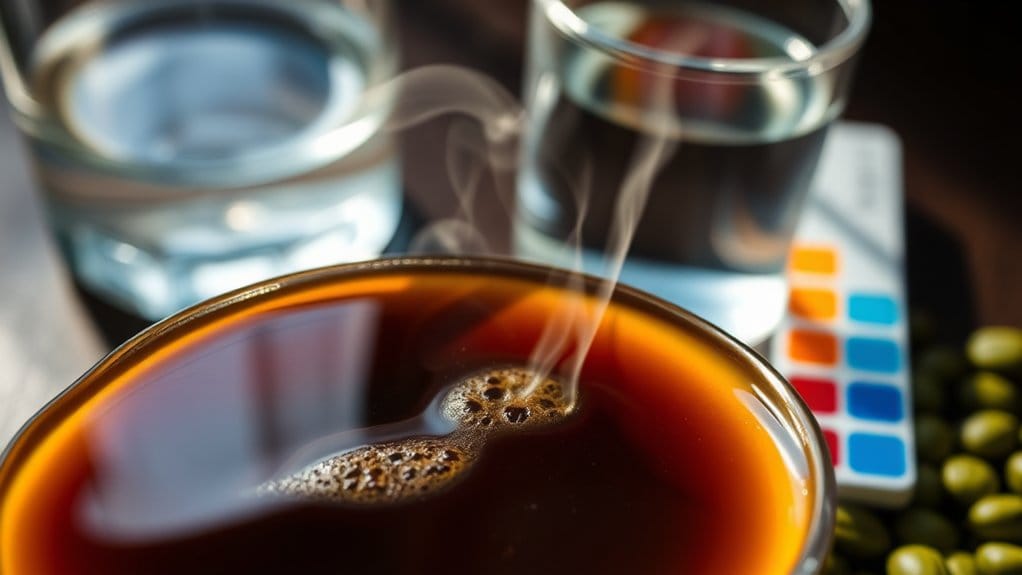
Understanding the pH level of your coffee can really change how you experience that perfect cup. Coffee usually sits between pH 4.5 and 6, meaning it’s naturally acidic. If you brew at a lower pH, around 4.85, your cup will taste bright and fruity, like a lively performance on your tastebuds. But if your pH rises to 5.4, expect a smoother, less sharp taste, almost like a cozy hug. Did you know cold brew is less acidic? That’s right! It’s like the chill friend of hot coffee. Coffee acidity can also be influenced by the type of beans you choose and how they’re roasted. Remember, your beans’ type and roasting level likewise play a role. Light roasts keep the acidity alive, whereas dark roasts soothe it.
You’ve explored how pH levels can really shift the acidity in your coffee, but there’s more to contemplate than just the beans and brewing technique.
Different water sources can dramatically impact your cup. Take Iceland’s glacial water, for example. Its purity creates a smooth, invigorating brew that showcases coffee’s natural flavors.
Or consider New York tap water, which provides balanced and flavorful coffee from protected reservoirs.
We can’t forget Melbourne’s rainwater, producing sweet cups bursting with flavor nuances.
Even London’s hard water, when filtered, can yield delightful caramel and citrus notes.
Have you ever thought about what water can do? Your coffee’s character starts with the source.
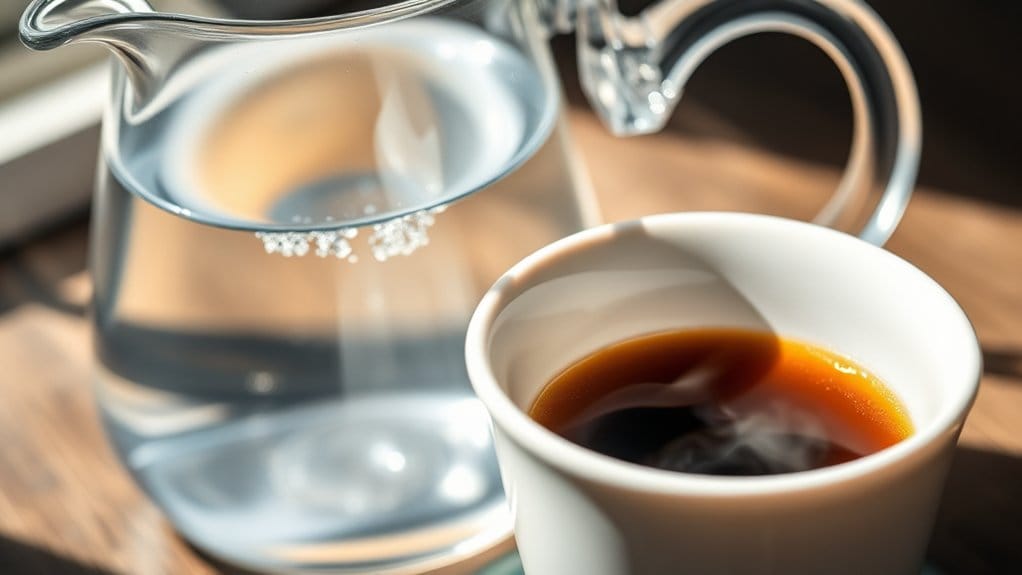
Regarding brewing coffee, the temperature of your water can make or break your cup. If your water’s too hot, you risk brewing a bitter mess that could wake the dead!
The sweet spot for brewing lies between 90°C and 96°C. This range extracts the glorious flavors locked in those coffee beans. If it’s too cool, your coffee might taste weak or sour, like a sad face on a rainy day.
Imagine a well-balanced brew, where the acidity sways with the sweetness. To achieve that, you need precision. Additionally, selecting the right grind size ensures the best flavor extraction during brewing. So, check your kettle and let it cool for a minute after boiling.
When you brew coffee, the quality of your water is just as crucial as the beans you choose.
Start by testing your water’s hardness and pH levels. Aim for a hardness of 50-80 ppm for espresso, and around 100 ppm for filter coffee. You want that perfect balance!
Don’t forget about mineral content—calcium and magnesium are your friends here.
Use clean water, free from chlorine or funky odors, ensuring it stays fresh in a sealed container. Avoid plastic that can ruin taste. Store your water away from sunlight and heat.
Finally, keep your coffee machine water reservoir clean. It’s like keeping your coffee’s home tidy—everyone appreciates a clean space!
Don’t let poor water spoil your delicious brew!
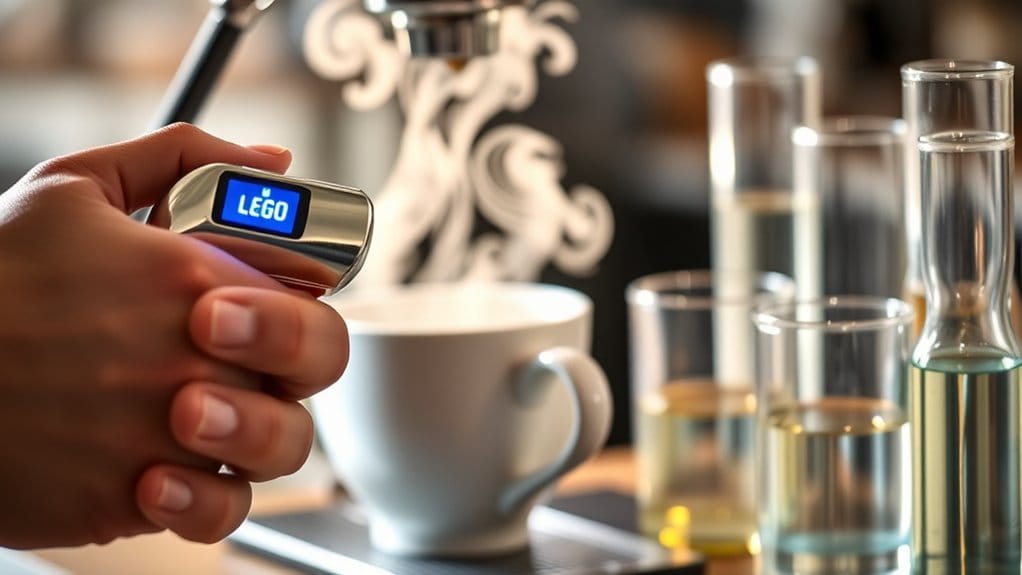
To achieve that perfect cup of coffee, understanding how to test and adjust your water is essential.
Start by measuring hardness, aiming for 50-80 ppm for espresso. Check alkalinity, as it buffers acidity and balances flavor. Keep that pH between 6.5 and 7.5—too high or low can make your coffee taste wonky! Total dissolved solids should hover around 100-200 ppm for ideal brewing.
You’ve got options for testing, like simple water test strips or high-tech colorimeters.
Once you know your numbers, consider filtering your water to improve consistency. Adjust mineral content if necessary, and don’t forget about temperature control—brewing between 195-205°F works wonders!
With a little attention, you’ll brew a consistently delicious cup every time!
Water quality directly influences your coffee’s aroma and flavor notes. By adjusting mineral levels and pH, you can improve fruity, floral, or bright characteristics as well as avoiding bitterness or a flat taste. Consistency is key!
Yes, you can use bottled water for brewing coffee, but choose wisely. Look for options with moderate mineral content to improve flavor extraction during avoiding issues like over-extraction or flat taste. Not all bottled waters are ideal.
Well water can greatly affect your coffee’s taste. Minerals improve extraction, as well as the absence of chlorine guarantees a cleaner flavor. The pH level and organic compounds additionally subtly influence aroma and bitterness in your brew.
Tap water isn’t always suitable for brewing coffee. Depending on mineral content, it can lead to bitterness or muted flavors. For the best results, test your water’s composition to guarantee a balanced extraction.
Water temperature greatly impacts caffeine extraction in coffee. Higher temperatures boost caffeine solubility and extraction speed, whereas too high risks bitterness. Ideal brewing occurs between 90°C and 96°C, balancing caffeine yield and flavor quality.